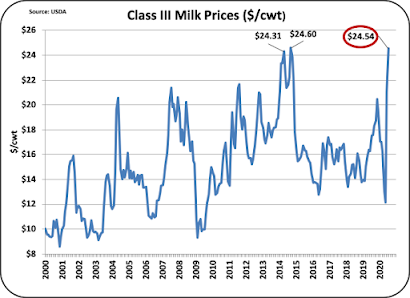What are “Outliers?” “Outliers” is a word made popular by Malcolm Gladwell. It refers to data that does not fit the norm. The Coronavirus has created significant “Outliers” in dairy data. The data simply does not fit any past data. These dairy outliers happened so fast and are so extreme that they are difficult to understand, and accurate forecasts are impossible. This post will focus on dairy outliers. The “Outliers” have created significant surprises in dairy pricing, some good and some not so good. It is also difficult to forecast when the “Outliers” will disappear and when there will be a return to normal.
The price of cheese in July 2020 reached a record at $2.59 per pound (Chart I). That price was 10 percent higher than any other prior NASS cheese price. It is also double the price of cheese only two months ago. The cheese price is really the driver behind most of the outliers in current dairy data.
The price of cheese has increased the value of milk protein to new record high of $5.63 per pound in July (Chart II). That is 20 percent higher than the previous record high achieved in 2008. It is also 170 percent higher than the price of cheese just two months ago.
This is an especially important factor for producers because the amount of milk protein can be increased through feed additives that at the current protein price provide a huge ROI. Increased protein levels are always worth the cost of feed additives, but at $5.63 per pound, the financial returns are a great opportunity,
The Class III price (Chart III) did not reach a record high in July at $24.54 per cwt. However, it was within four cents of being a record high. The prior high occurred six years ago. The Class III price increased over 100 percent in just two months.
Chart V illustrates the PPD for the Northeast Federal Order. The PPD differs for each Federal Order and the Northeast Federal Order was chosen for this chart because it is a large Federal Order and because it has a balance of milk usage covering all four milk Classes. The chart covers the PPD for all months starting in 2000 through June 2020. The negative PPD in June is 126 percent greater than the previous low PPD which occurred in 2004. In just one month it has dropped by $6.71 per cwt.
What do all these “Outliers” mean? The first notable fact is that dairy “Outliers” like this have no precedent. There is no history to follow. “Outliers” usually disappear quickly, however, the current pandemic is far from over. People are still primarily eating at home and buying their groceries at retailers. Food service is still in a major slump. The Coronavirus Food Assistance Program (CFAP) is also far from over.
Prices as followed on the CME show significantly declining future cheese prices. It seems reasonable that they are going down after reaching record highs.
There are currently no answers or basis for when the “Outliers will be replaced by more normal analytics, but the data will continue to be followed in future posts to this blog.
Source: Milkprice














